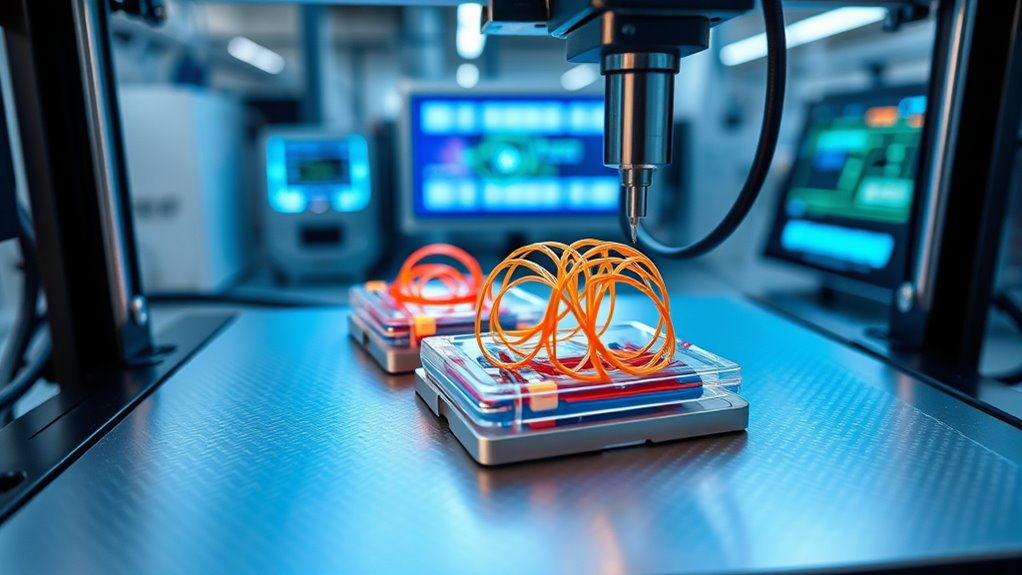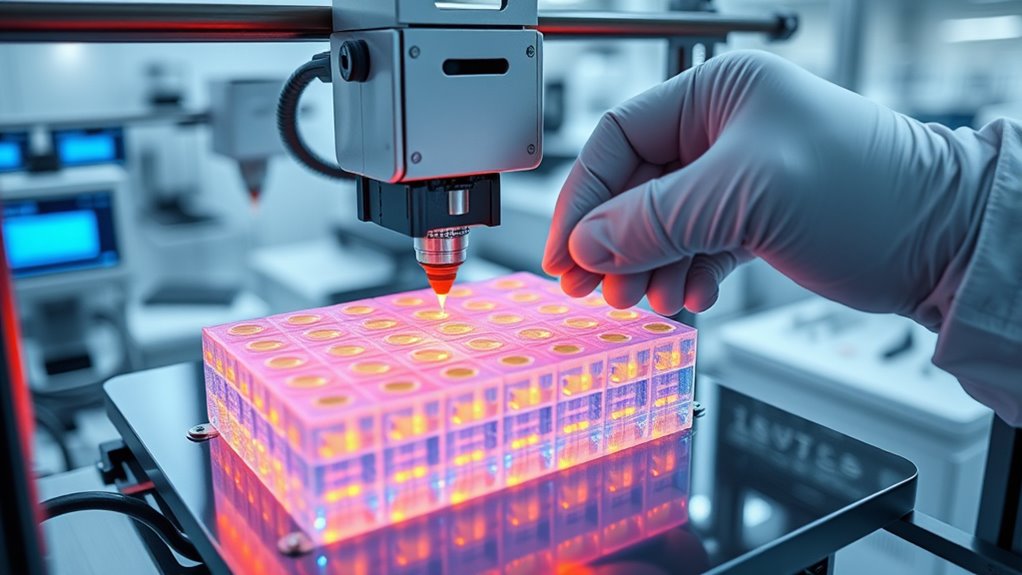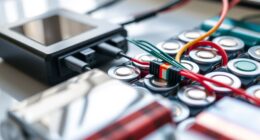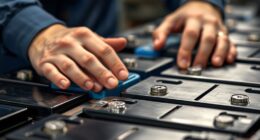3D printing in battery manufacturing is opening up new possibilities with emerging techniques like inkjet, extrusion, and laser-based methods. These approaches allow you to create complex, customized structures quickly, improve material contact, and enhance performance. You can also produce safer solid electrolytes and electrodes optimized for specific needs. As these methods evolve, you’ll discover how they enable faster, more reliable, and innovative battery designs—so keep exploring to learn more about these exciting advancements.
Key Takeaways
- Advanced 3D printing methods like inkjet, extrusion, and laser techniques enable precise fabrication of battery components.
- Emerging techniques allow direct printing of complex solid electrolytes with enhanced ionic conductivity.
- Multi-material 3D printers facilitate seamless integration of electrodes, electrolytes, and current collectors in a single process.
- Innovations include graded materials and tailored porosity to improve battery performance and lifespan.
- Scalable manufacturing methods are developing to produce complex, efficient batteries for electric vehicles and portable devices.

3D printing is transforming battery manufacturing by enabling rapid prototyping, customized designs, and complex structures that were previously difficult to produce. This innovative approach allows you to quickly test new concepts, optimize performance, and tailor batteries to specific applications. One of the most promising areas is the development of solid state electrolytes, which are safer and more stable than traditional liquid electrolytes. With 3D printing, you can precisely deposit solid electrolyte materials in intricate geometries, enhancing ionic conductivity and mechanical stability. This precision guarantees better contact between electrolyte and electrodes, leading to improved battery performance. Additionally, the ability to print complex electrolyte structures simplifies the integration of solid state components, making scalable manufacturing more feasible. Given the ongoing research into AI security and the importance of safety measures, developing secure printing processes will be essential to prevent potential vulnerabilities.
Electrode fabrication benefits notably from 3D printing as well. Instead of relying on traditional slurry casting or stacking layers manually, you can directly print electrodes with controlled porosity, texture, and composition. This control enables you to optimize the surface area for electrochemical reactions, increasing energy density and charge/discharge rates. You can also create electrodes with graded materials, tailoring properties across the structure for better stability and longevity. The flexibility of 3D printing means you’re no longer constrained by standard formats; instead, you can design electrodes that fit specific spatial constraints or performance requirements. This leads to lighter, more efficient batteries, especially valuable for applications like electric vehicles and portable electronics.
Furthermore, 3D printing streamlines the integration of multiple components into a single, cohesive unit. Traditional manufacturing involves multiple steps and assembly, increasing the risk of defects and misalignments. With additive manufacturing, you can print entire battery architectures in one process, embedding electrolytes, electrodes, and current collectors seamlessly. This not only reduces manufacturing time but also enhances structural integrity and reliability. As you explore different materials and printing techniques—like inkjet, extrusion, or laser-based methods—you gain the ability to customize each component’s properties, resulting in batteries that are precisely engineered for specific performance goals.
Frequently Asked Questions
How Does 3D Printing Impact Battery Recycling Processes?
You’ll find that 3D printing improves recycling efficiency and material recovery in battery processes. It allows you to design precise, customizable components, making disassembly easier and reducing waste. With 3D printing, you can create modular parts that simplify recycling, ensuring valuable materials are recovered more effectively. This technology also minimizes contamination, enhancing the quality of recycled materials, and ultimately contributes to more sustainable and cost-effective battery recycling practices.
What Are the Safety Considerations for 3D Printed Batteries?
When working with 3D printed batteries, you need to consider safety carefully. Material stability is vital to prevent leaks or degradation, which could lead to fire hazards. Always make certain your materials are compatible and properly tested for stability under different conditions. Handle batteries with care, avoid overcharging, and store them safely to minimize risks. Following safety protocols helps prevent accidents and guarantees your batteries operate reliably.
Can 3D Printing Be Used for Large-Scale Battery Production?
You can use 3D printing for large-scale battery production, but scaling limitations and material challenges pose significant hurdles. While additive manufacturing offers customization and rapid prototyping, producing large quantities efficiently remains difficult. You’ll need to address issues like ensuring consistent material properties, optimizing print speeds, and managing costs. Overcoming these challenges is essential if you want to implement 3D printing effectively in mass battery manufacturing.
How Do 3D Printed Batteries Compare in Lifespan to Traditional Ones?
You’ll find that 3D printed batteries generally have comparable battery longevity to traditional ones, but this depends on material durability. Advances in 3D printing materials enhance durability, which helps extend lifespan. However, because 3D printing allows for custom designs, you might experience variations in longevity. Overall, as material science improves, 3D printed batteries are becoming more reliable, offering lifespan similar to conventional batteries while allowing for innovative features and tailored performance.
What Are the Cost Implications of Adopting 3D Printing in Battery Manufacturing?
You might think adopting 3D printing in battery manufacturing costs a lot, but it actually offers significant cost reduction and boosts manufacturing efficiency. As you incorporate this technology, you’ll save on material waste and streamline production, leading to lower expenses. The initial investment pays off over time, making your process more sustainable and competitive. Embracing 3D printing means you’re not just innovating—you’re optimizing costs and efficiency simultaneously.
Conclusion
As you explore these emerging 3D printing techniques, remember that innovation often starts with a single step. By embracing these advances, you can revolutionize battery manufacturing and stay ahead of the curve. Keep in mind, “Rome wasn’t built in a day,” but with persistence and ingenuity, your breakthroughs can shape the future of energy storage. Stay curious, stay committed, and watch how your efforts transform the industry.










